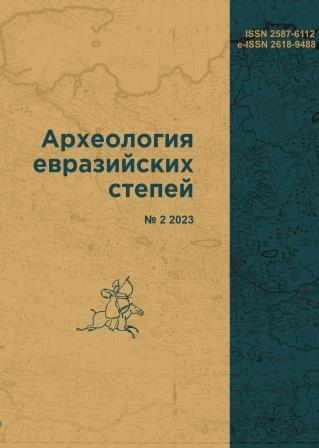Ananyino Settlement on the Kremlin Headland in the Sity of Kazan
DOI:
https://doi.org/10.24852/2587-6112.2023.2.182.195Keywords:
archaeology, Early Iron Age, Ananyino cultural-historical area, Kazan Kremlin, settlement, post-Maklasheyevka culture, topographic situationAbstract
The first finds of the Early Iron Age on the territory of the Kazan Kremlin were found in the late 19th and early 20th centuries. Analysis of excavation collections of the end of the 20th century allowed to determine that pottery and individual finds of that time are fixed on the north-western end of the Kremlin headland on the square of 14487 m2. Reconstruction of the Early Iron Age topographic situation has revealed the reason for the settling on this area. The north-western part of the Kremlin headland in the Early Iron Age was divided by a hollow and its eastern side had an elevated and uneven surface that predetermined the choice of the western end as the location of the Ananyino cultural-historical area settlement. The Early Iron Age pottery assemblage, received during archaeological works at the Kazan Kremlin, refers mainly to the post-Maklasheyevka culture, there is also textile ceramics of the Akozino-Akhmylovo culture in this complex. The analysis of the ceramic assemblage and individual finds made it possible to make a conclusion that a permanent settlement of the post-Maklasheyevka culture ACHA existed on the site of the north-western end of the Kazan Kremlin for a long time in the IX–IV centuries BC.
References
Ashikhmina, L. I. 2014. Genezis anan’inskoi kul’tury v Srednem Prikam’e (po materialam keramiki i zhilishch) (Genesis of the Ananyino Culture in the Middle Kama Area (According to the Ceramics and Dwellings)). Series: Arkheologiia evraziiskikh stepei (Archaeology of the Eurasian Steppes) 19. Kazan: Institute of Archaeology named after A. Kh. Khalikov, Tatarstan Academy of Sciences; “Otechestvo” Publ. (in Russian).
Ashikhmina, L. I., Chernykh, E. M., Shatalov, V. A. 2006. Vyatskiy kray na poroge zheleznogo veka: kostyanoy inventar' anan'inskoy epokhi (I tysyacheletie do n. e.). (Vyatka region at the threshold of the Iron Age: bone inventory of the Ananyino epoch (1st millennium BC)). Izhevsk: Udmurt State University (in Russian).
Dedkov, A. P., Butakov, G. P. 1990. In Perevedentsev, Yu. P., Trofimov, A. M. (eds.). Nauchnyy putevoditel' po Kazani i okrestnostyam (K IX s"ezdu Geograficheskogo obshchestva SSSR) (Scientific guide to Kazan and its surroundings (for the IX Congress of the geographical society of the USSR)). Kazan: Kazan State University, 3–19 (in Russian).
Kuzminykh, S. V. 1983. Metallurgiia Volgo-Kam’ia v rannem zheleznom veke (med’ i bronza) (Metallurgy of the Volga-Kama Region during the Early Iron Age (Copper and Bronze)). Moscow: “Nauka” Publ. (in Russian).
Kuzminykh, S. V., Chizhevsky, A. A. 2018. In Povolzhskaya arkheologiya (Volga River Region Archaeology) 9 (3), 101–137 (in Russian).
Markov, V. N. 1984. In Khalikov, A. Kh. (ed.). Arkheologicheskie pamiatniki Nizhnego Prikam’ia (Archaeological Sites of the Lower Kama Region). Kazan: G. Ibragimov Language, Literature and History Institute, Kazan Branch of the USSR Academy of Sciences, 5–17 (in Russian).
Markov, V. N. 1985. In Arkhipov, G. A. (ed.). Arkheologiia i etnografiia Mariiskogo kraia (Archaeology and Ethnography of Mari Land) 9. Yoshkar-Ola: Mari Scientific and Research Language, Literature, and History Institute, 38–56 (in Russian).
Markov, V. N. 1987. In Soloviev, B. S. (ed.). Drevnosti Srednego Povolzh'ia (Antiquities of the Middle Volga Region). Series: Arkheologiia i etnografiia Mariiskogo kraia (Archaeology and Ethnography of the Mari Land) 13. Yoshkar-Ola: Mari Research Institute of Language, Literature, and History, 102–130 (in Russian).
Markov, V. N. 2007. Nizhnee Prikame v ananinskuiu epokhu (The Lower Kama River Region during the Ananyino Epoch). Series: Arkheologiia Evraziiskikh stepei (Archaeology of Eurasian Steppes) 4. Kazan: Institute for History named after Sh. Mardzhani, Tatarstan Academy of Sciences (in Russian).
Sitdikov, A. G., Khuzin, F. Sh. (eds.). 2007. Svod pamiatnikov arkheologii Respubliki Tatarstan (Corpus of Archaeological Sites in the Republic of Tatarstan) 3. Kazan: Institute of History named after Shigabuddin Mardzhani, Tatarstan Academy of Sciences (in Russian).
Sitdikov, A. G. 2006. Kazanskii Kreml’: istoriko-arkheologicheskoe issledovanie (Kazan Kremlin: Historical and Archaeological Study). Kazan: “Foliant” Publ. (in Russian).
Sitdikov, A. G. 2010. In Uchenye zapiski Kazanskogo gosudarstvennogo universiteta. Seriia Gumanitarnye nauki (Scientific Bulletin of the Kazan State University. Series: Humanities). Vol. 152, book 3, part 1, 97–106 (in Russian).
Chizhevsky, A. A. 2019. In Arkheologiia Evraziiskikh stepei (Archaeology of Eurasian Steppes) 4, 196–256 (in Russian).
Chizhevsky, A. A. 2008. In Ovsyannikov, V. V. (ed.). Ufimskii arkheologicheskii vestnik (Ufa Archaeological Herald) 8. Ufa: “Gilem” Publ., 91–98 (in Russian).
Chizhevsky, A. A. 2012. In Vishnyatsky, L. B. (ed.-in-chief). Rossiiskii arkheologicheskii ezhegodnik (Russian Archaeological Yearbook) 2. Saint Petersburg: Saint Petersburg University, 383–399 (in Russian).
Chizhevsky, A. A. 2018. In Povolzhskaya arkheologiya (Volga River Region Archaeology) 35 (1), 159–177 (in Russian).
Chizhevsky, A. A., Antipina, E. E., Asylgaraeva, G. Sh., Nuretdinova, A. R. 2019а. In Povolzhskaya arkheologiya (Volga River Region Archaeology) 27 (1), 84–103 (in Russian).
Chizhevsky, A. A., Galimova, M. Sh.2010. In Nauchnyi Tatarstan (Scientific Tatarstan) (4), 127–136 (in Russian).
Chizhevsky, A. A., Galimova, M. Sh., Gubaidullina, A. V. 2019. In Arkheologiia Evraziiskikh stepei (Archaeology of Eurasian Steppes) 2, 124–164 (in Russian).
Chizhevsky, A. A., Khisyametdinova, A. A. 2020. Defensive structures of the cape settlements of the Volga-Kamya in the Early Iron Age and early Middle Ages. In Arkheologiia Evraziiskikh stepei (Archaeology of Eurasian Steppes) 2, 8–277 (in Russian).
Chizhevsky, A. A., Chernykh, E. M., Korenyuk, S. N. 2021. In Sitdikov, A. G., Chizhevsky, A. A. (eds.). Rannii zheleznyi vek (Early Iron Age). Series: Arkheologiia Volgo-Uralia (Archaeology of the Volga-Urals) Vol. 3. Kazan: Institute of Archaeology named after A. Kh. Khalikov, Tatarstan Academy of Sciences, 186–216 (in Russian).

Downloads
Published
How to Cite
Issue
Section
License
Copyright (c) 2023 A.A. Chizhevsky, A.G. Sitdikov, A.A. Khisyametdinova, G.M. Sayfutdinova

This work is licensed under a Creative Commons Attribution-NonCommercial 4.0 International License.







